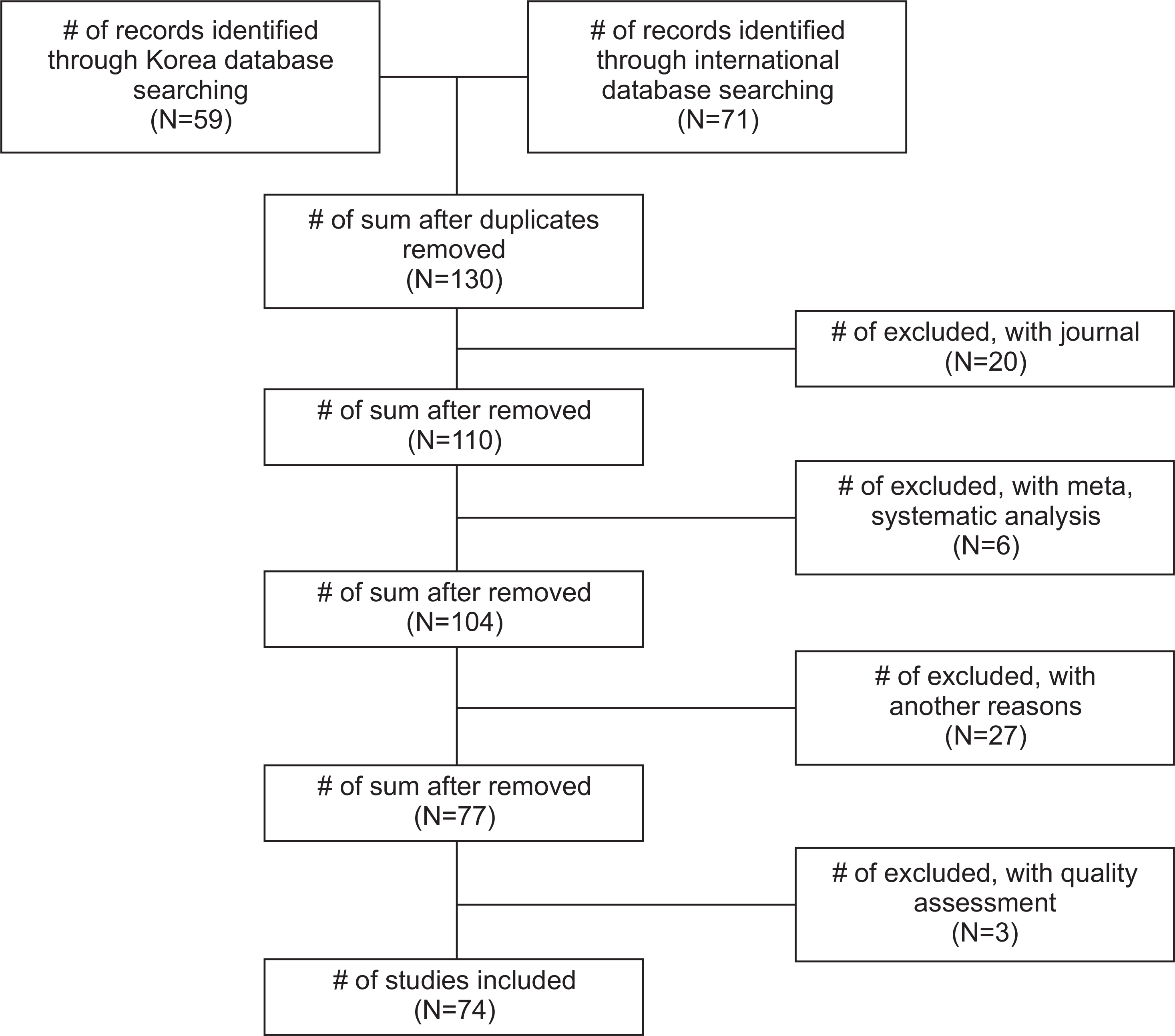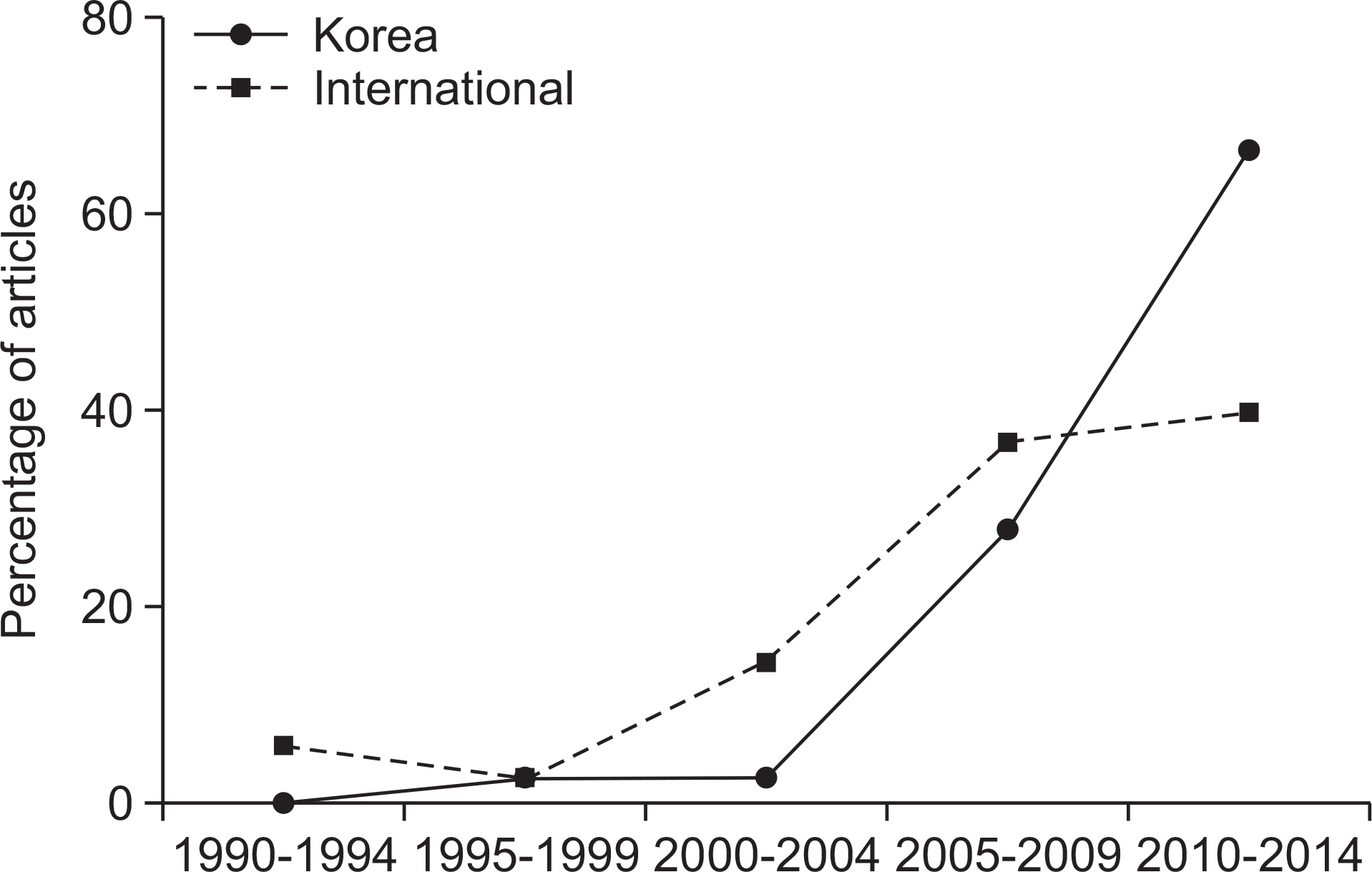J Korean Acad Oral Health.
2015 Dec;39(4):229-236. 10.11149/jkaoh.2015.39.4.229.
Review on dental fear and anxiety factors by DFS
- Affiliations
-
- 1Department of Preventive and Community Dentistry, Institute of Oral-bio Science, School of Dentistry, Chonbuk National University, Jeonju, Korea. prevdent@jbnu.ac.kr
- KMID: 2151776
- DOI: http://doi.org/10.11149/jkaoh.2015.39.4.229
Abstract
OBJECTIVES
The study on dental fear has increased recently. Studies found that people with high dental fear and or anxiety were less likely to visit dentists. The aim of this study is to review the trend of study on dental fear and to analyse the major factors related to dental fear.
METHODS
Seventy four papers listed in Korea Citation Index and SCI(E) were assessed. Quality Assessment and Validity Tool for Correlation Studies (QAVTCS) and Dental Fear Study (DFS) were used in this study. SPSS 12.0 was employed to analyse the descriptive statistics, t-test and Multiple Linear Regression (MLR) with stepwise.
RESULTS
The total mean score of QAVTCS for international studies was significantly higher than domestic studies (P=.001). The mean scores of item, 'Seeing the anesthetic needle' and 'Feeling the anesthetic needle', were severe level (Means= 3.05, 3.14, severe>3.00). According to the MLR, the powerful predisposing factors (independent variable) on 'Overall fear of dentistry (dependent variable)' were 'Hearing the drill' (P<.01) and 'Having teeth cleaned' (P<.05).
CONCLUSIONS
It was concluded that people had high dental fear in direct dental treatment environment such as contact with seeing anesthetic needle and hearing dental drill. Therefore, this study suggests the need to map out specific and multidirectional plan for decreasing dental fear.
Keyword
MeSH Terms
Figure
Reference
-
References
1. Cohen LA, Snyder TL, LaBelle AD. Correlates of dental anxiety in a university population. J Pub Health Dent. 1982; 42:228–235.
Article2. Kleinknecht RA, Klepac RK, Alexander LD. Origins and characteristics of fear of dentistry. J Am Dent Assoc. 1973; 86:842–848.
Article3. Jun BH. Descriptive literature review on dental fear in Korea (2004-2012). J Korean Soc Dent Hyg. 2014; 14:251–259.4. Hong SH, Oh JS. A relevant factor analysis on dental treatment fear in some high school students. J Korean Soc Dent Hyg. 2012; 12:741–749.
Article5. Choi JS, Kim KK. Relationships between dental fear and dental services utilization with respect to oral health promotion. J Korean Soc Health Educ Prom. 2006; 23:47–65.6. Choi JS, Han SJ, Lee MJ, Han GS. Factors associated with the dental fear level and sub-factors of the dental fear survey scale. J Korean Acad Oral Health. 2009; 33:51–61.7. Choi SS, Kim JY, Song KB, Lee SK. Analysis of the related factors of dental fear among teenagers in private dental clinics. J Korean Acad Oral Health. 2004; 28:495–503.8. Dobros K, Hajto-Bryk J, Wnek A, Zarzecka J, Rzepka D. The level of dental anxiety and dental status in adult patients. J Int Oral Health. 2014; 6:11–14.9. Schuller AA. Are there differences in oral health and oral health behavior between individuals with high and low dental fear? Community Dent Oral Epidemiol. 2003; 31:116–121.
Article10. Jeon YS. The effect of music listening on anxiety and pain reduction of dental treatment. Korean J Music Therapy. 2004; 6:35–47.11. Kritsidima M, Newton T, Asimakopoulou K. The effects of lavender scent on dental patient anxiety levels: a cluster randomised controlled trial. Community Dent Oral Epidemiol. 2010; 38:83–87.12. Cummings G, Estabrooks CA. The effects of hospital restructuring that included layoffs on individual nurses who remained employed: A systematic review of impact. Int J Sociol. 2003; 23:8–53.
Article13. Estabrooks CA, Floyd JA, Findlay SS, O’Leary KA, Gushta M. Individual determinants of research utilization: a systematic review. J Adv Nurs. 2003; 43:506–520.
Article14. Estabrooks CA, Goel V, Thiel E, Pinfold P, Sawka C, Williams I. Decision aids: are they worth it? a systematic review. J Health Serv Res Policy. 2001; 6:170–182.
Article15. Lee JS. Education·psychology·society research methodology. Seoul: Kyoyookbook;2012. p. 174–179.16. Carter AE, Carter G, Boschen M, AlShwaimi E, George R. Pathways of fear and anxiety in dentistry: a review. World J Clin Cases. 2014; 2:642–653.
Article17. Kim SK, Kim MH, Choi HJ, Hwang JG. Related factors to dental fear in some adults. J Korean Soc Dent Hyg. 2014; 14:881–886.
Article18. Lee HY, Na MH, Lee YH. Analysis of related factors for dental fear. J Korean Soc Dent Hyg. 2012; 12:57–65.
Article19. Kim JH, Jeong HJ, Kim HJ. A Study on personal temperament, dental knowledge and dental fear of high school students. Korean J Health Service Management. 2013; 7:1–12.
Article
- Full Text Links
- Actions
-
Cited
- CITED
-
- Close
- Share
- Similar articles
-
- What is the gold standard of the dental anxiety scale?
- Reliability and validity of the Korean version of the Dental Fear Survey
- Verification of the Korean Version of the Dental Fear Survey
- Dental fear & anxiety and dental pain in children and adolescents; a systemic review
- Analysis and Consideration of Factors for Predicting Cooperation Levels in Pediatric Dentistry



